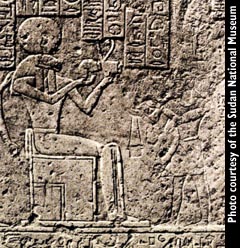
|
|
Detail from a stele found at Jebel Barkal, showing King Piankhy (right) before the ram-headed god Amun. The god is handing the king the crowns of Kush and Egypt. (Note that someone who disliked the king once tried to erase his image and that later someone wishing to honor him had it carved again.)
|
FFor a long time scholars have disagreed on how to read this king�s name, since it is not clear whether it was read as an Egyptian name or a Nubian one. In either case, it seems to have meant "The Living One," which was another way of saying "Eternal Pharaoh." Obviously, this was not the king�s name when he was born, but what this name was we do not know.
Piankhy (also known as Piye) was the first Kushite king to take control of a large part of Egypt. Early in his reign he marched on southern Egypt with his army and made his sister, Amenirdis, the living wife of the god Amun at Thebes. About 726 BCE he invaded again and attacked northern Egypt. The princes of northern Egypt surrendered and accepted Piankhy as their emperor. He then returned to Napata and spent the rest of his reign rebuilding the Jebel Barkal temples that were first built by the Egyptian kings seven hundred years before.
In his inscriptions he tells us that he greatly loved horses. He had parades of horses carved on the walls of the Great Amun Temple; and he was buried in a pyramid near the graves of four of his horses.
|